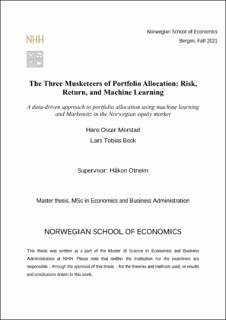The Three Musketeers of Portfolio Allocation: Risk, Return, and Machine Learning: A data-driven approach to portfolio allocation using machine learning and Markowitz in the Norwegian equity market
Master thesis
Permanent lenke
https://hdl.handle.net/11250/2982776Utgivelsesdato
2021Metadata
Vis full innførselSamlinger
- Master Thesis [4372]
Sammendrag
The portfolio selection problem is one of the most discussed topics in financial literature. Harry
Markowitz (1952) is recognized as the first to formalize the risk-reward trade-off methodology
used in portfolio selection. Through his mean-variance framework, he detailed the importance
of diversification and laid the foundation for the modern portfolio theory we know today.
This thesis explores a novel approach to portfolio allocation enabling the mean-variance
framework and machine learning. We employ machine learning to predict the quarterly
expected return and the associated covariance matrix for stocks trading on Oslo Stock
Exchange. To construct the predictions, we deploy the renowned Extreme Gradient Boosting
algorithm, also called XGBoost. We investigate the opportunity to use quarterly reports,
macroeconomic and economic variables as predictors of quarterly stock returns and
covariances. Furthermore, we apply these predictions in the mean-variance framework from
Markowitz to construct quarterly portfolios.
The results from the Thesis Model are disappointing. The objective of the quarterly portfolio
optimization is to maximize the Sharpe ratio. Unfortunately, the Thesis Model is not able to
construct portfolios that reliably aligned with this goal. Nevertheless, the model initially yields
an impressive one-year return. However, under new conditions the performance change
drastically. The statistical evaluation of the XGBoost prediction models entails that they both
deliver highly inaccurate predictions, which propagates further through to the portfolio
allocation process. Moreover, there is little evidence that the models can detect any patterns in
the data beneficial for portfolio construction. In sum, the model struggles to foresee market
developments, which accumulates into a model incapable of consistently performing with
satisfying financial results.
